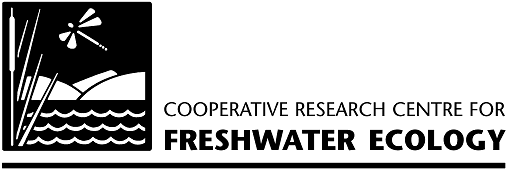Publication (Media): Researchers Make Rare Find in Cotter River
| Publication Type: | Media Release |
| Publication Name: | Researchers Make Rare Find in Cotter River |



Reference Information
| Lintermans, M. and Sealie, L. (2002) Researchers Make Rare Find in Cotter River - May 21 2002, CRCFE, Canberra - Media Release. |



 Optional Information Optional Information
 Optional Information Optional Information

Other information:

 
21 May 2002 FOR IMMEDIATE USE
Researchers Make Rare Find in Cotter River
A small group of Macquarie Perch, endangered across Australia, are happily swimming in the protected waters of the Cotter River. They provide a rare opportunity for University of Canberra and Environment ACT researchers to study these fish in an effort to increase their numbers.
It’s early days in the Cotter project, but Mark Lintermans and his team from Environment ACT have already uncovered some interesting surprises - it seems Macquarie Perch are strongly nocturnal (active at night), have fairly small territories and don’t travel far to breed, unlike other large native fish.
“Because they only use a small part of the river for breeding, it makes sense to protect that highly valuable part of the river,” Mr Lintermans said.
The research team was surprised to find that the Cotter group are nearly all female – 24 out of the 25 adult fish that have been radio-tracked are female.
“To conserve a species of fish, we need to protect their breeding and feeding habitats,” said Mark Lintermans, “There are now so few Macquarie Perch left that we are learning as much as we can about the Cotter group to try and build their numbers up. We are discovering where the fish like to live and how far they need to move to live and breed and sustain a healthy population.”
Also being studied in the Cotter project is the locally threatened Two-spined Blackfish, a beautifully patterned native fish with some unusual breeding habits. After the female blackfish glues her large eggs to a stone, the male fish guards and fans the eggs constantly for 15-16 days until they hatch. He then watches over them for another 3-4 weeks until they are ready to swim off.
Two more teams of researchers from the University of Canberra’s CRC for Freshwater Ecology are working on the Cotter project in an effort to conserve the populations of threatened fish - one team are focusing on the fish’s food needs while the other team are investigating their habitat needs.
For this project, ACTEW AGL are opening the floodgates on Bendora Dam and releasing a higher-than-usual flow for 48 hours every month.
“What we’re trying to do is bring back a more natural pattern of flows by re-introducing some higher than usual flows,” explains Dr Fiona Dyer, “We’re then studying the different flows to work out what the best flow pattern is for the Macquarie Perch and Two-spined Blackfish. Is there more habitat and food available for them under certain flow patterns?”
Another University of Canberra team is studying the fish’s food chain and how it is affected by more natural flows. Water bugs that feed on algae are important food sources for these fish.
“Just 1-2 days after the flushing flows, the algae is revitalised and grows back stronger, just like a lawn springs back after being mowed,” says Associate Professor Richard Norris. “This is likely to affect the whole food chain including the water bugs and the fish”.
“What we learn from the Cotter project about tailoring flow releases to achieve environmental benefits can be applied in many other rivers. The Cotter work can be used to assist many communities who are preparing river management plans,” says project coordinator Dr John Whittington.
P.S. Catching Macquarie Perch is illegal in the ACT and NSW.
Photos and interviews
Digital images of researchers working at the Cotter, Macquarie Perch and Two-spined Blackfish are available. Interviews available with Mark Lintermans on 02 6207 2117, Email: mark.lintermans@act.gov.au AND Fiona Dyer on 02 6201 2267, Mobile: 0407 281 441. For media assistance, please call Lynne Sealie on 02 6201 5168 (BH); 02 6247 4108 (AH); Email: lsealie@enterprise.canberra.edu.au Field trips for photo shoots can be arranged.
Cotter Quiz
1. The Cotter River is Canberra’s preferred drinking water supply. Where does Canberra’s drinking water come from if the Cotter is unavailable?
2. What are the three dams on the Cotter River called?
3. What’s so good about Canberra’s water supply from the Cotter?
Answers
1. Googong Dam, NSW.
2. Corin, Bendora and Cotter Dams.
3. Because it comes from an uninhabited, forested catchment with high, reliable rainfall, the water is high-quality and only needs minimal treatment –that means fewer chemicals for the consumer. Canberra water is free of taste and odour problems and low in dissolved salts.
|



 Search classifications Search classifications
 Search classifications Search classifications

| Article location: | | CRCFE project number: | |
| Region: | | State/Territory: | |
| Country: | Australia | Data source: | |
| Assessment and monitoring: | |
| Biota (class): | |
| Biota (group): | |
| Discipline: | |
| Management issues: | |
| Mesohabitat: | |
| Macrohabitat: | |
| Partner organisation: | |



 Administration Administration
 Administration Administration

| Created: | 09/10/2004 04:18 PM |
| Lodged by: | Gail Ransom |
| Last modified: | 03/18/2005 01:09:46 PM |
| Modification history: | 09/10/2004 04:18:09 PM
09/10/2004 05:09:04 PM
09/10/2004 05:45:32 PM
09/28/2004 06:38:49 PM |
| Modified by: | CN=Gail Ransom/OU=UC/O=CRCFE |
| Document Id: | 34D34FF7BC37885ECA256F0B00229E1F |



|